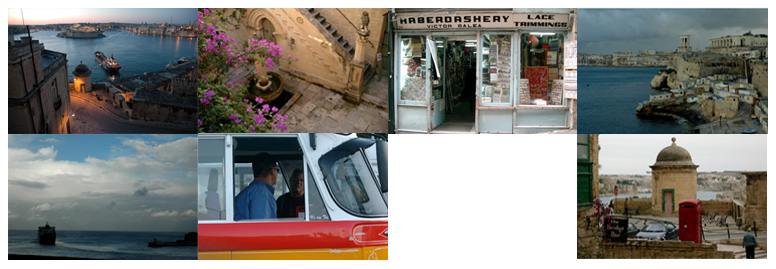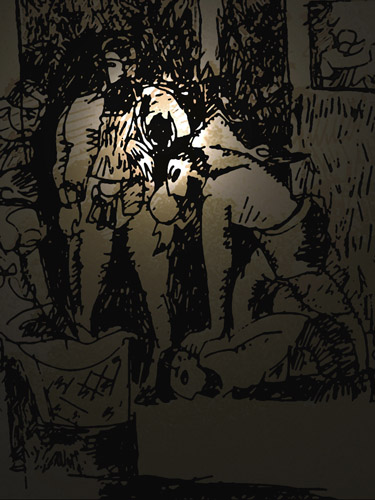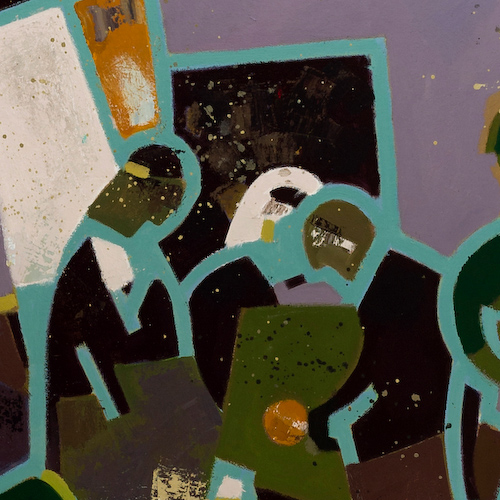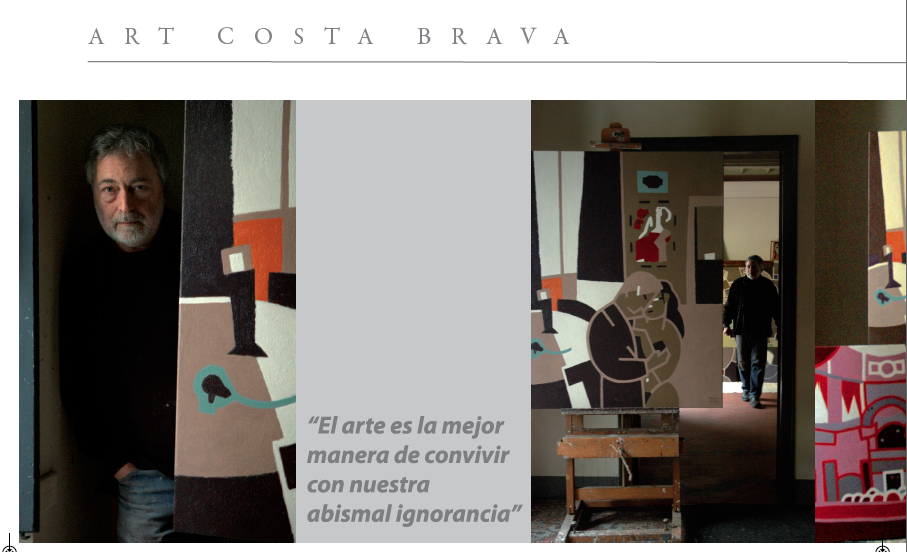
MALTA (REPUBLIC OF MALTA). THE SHCERMERHORN PAPERS.
Fragment of the homonym tale by Joan C. Roca Sans
ROME, NAPLES, PALERMO AND MALTA
The years of erratic life
Barrachini spoke as if he was at University:
“Caravaggio was accused of murder in Rome and he was awaiting pardon. He decided he needed to get away. Where should he go? Three days away, there was a large city where artistic trends, new ideas and the shudder of the uprisings against the Spanish converged: Naples. This was to be his next destination. There he would paint two masterpieces: The Madonna of the Rosary and The Seven Works of Mercy and a whole host of lesser paintings. When he had become the best known and the most prolific artist in Naples, he set sail for Malta in July 1607. Why? We are not sure, but it was probably the wish to secure the honorary Knight’s Cross as, because of his commoner origin, he could not be awarded the full Knight’s Cross. He doubtless also thought that it would be a way of ensuring that his sentence would be lifted. Almost as soon as he landed, and thanks to Malaspina, he was commissioned to paint Saint Jerome Writing for the Italian chapel of the cathedral. The Grand Master, Alof de Wignacourt, was pleased with the work and entrusted him with painting The Beheading of Saint John the Baptist. He then also painted his portrait and placed next to him a page, of whom it was said the Grand Master was very fond. He later painted a second portrait of him.
“Which got lost along the way” Calleja interrupted, wringing his hands together.
“Well” Barrachini answered, “The second portrait went missing, in fact, but there is yet another portrait of Wignacourt. If you look carefully, you will be able to see that Caravaggio used his features for the face of Saint Jerome.”
“That’s true!” Stafini said in a surprised voice. “I have seen this painting dozens of times and I have never noticed that. Of course he liked the painting; it flattered him, by placing him in full view of everyone and, in an irrefutable way, in eternal glory. That is how Caravaggio got the Knight’s Cross.”
On seeing that Barrachini was so well informed, Calleja asked him, serving him another glass of Bel, the characteristic wine of Malta, made with the local Ghirgentina and Gellrwza varieties.
“Why then, did Caravaggio fall into disgrace and become imprisoned and later expelled from the order?”
“At this point, we can only surmise. When the Grand Master commissioned the first portrait, Caravaggio could not help but add to the terrible warrior, represented in archaic armour, a page who was perhaps too handsome, holding Wignacourt’s fighting helmet.
This page with his provocative look would become famous. Delacroix reproduced him in his notebooks and he inspired Manet in his Boy with a Sword in the New York Metropolitan. The painting was bought by Louis XIV, in 1670, for fourteen thousand pounds.
However, the fact is that the page was a true provocation in the devout world of celibate knights, in which although dealings with women were tolerated and normal, the Order was very strict about crimes of sodomy or what is today called paedophilia. In any case, the actual accusation has not been found in the archives.
“Thank goodness that things aren’t like that now in Malta!” Calleja joked.
Stafini then joined the conversation.
“Well, I suppose my painting will end up making the situation worse.
Although this cupid is more discreet than the one that appears in The Madonna of the Palafrenieri, because a shadow covers the child’s attributes. I imagine that the painting was not very fitting for the atmosphere in La Valetta.
“Everything leads us to believe that.” Barrachini concluded. “It has been speculated that there was a plot against Caravaggio hatched by several knights who were offended by this Sleeping Cupid, which was indecorous and provocative.
Whatever the reason, this painting changed the course of the dizzy years its author had yet to live. After this, he was imprisoned and expelled from the Order, although he managed to flee to Syracuse, and then to Naples, where he still had time to paint several moving masterpieces. He died in Porto Ercole in July 1610, not far from the mouth of the River Tiber. A few days later, or perhaps earlier, Pope Paul V, giving in to the pleas of Caravaggio’s friends, placed his seal on the document that pardoned his life.”
© JC Roca Sans
The Sleeping Cupid
The murder of Caravaggio
PRESENTATION AT THE
PALAU-SATOR CASTLE
In the Palau-Sator Castle. Girona. (April 2009)

PALAU-SATOR CASTLE
INSTALATION
PRESENTATION
El castell de Benedormiens acull el projecte ‘Ermóupoli’

EXPLORING ORDER AND CHAOS
The pictorialism which marked the birth of photography has inverted its discourse and today it is no longer photographers who imitate painters, but painters who follow the path of photographic realism, which is always well received by the public. Are we looking at the end of manual and subjective creation of the image? Everything points that way. The presence of photographic image —cinema, television, video — in the contemporary world is complete. Nowadays hardly anybody, except perhaps children, draws from memory, in other words forming an image on paper in which what they have just seen corresponds to 10% of the results, whilst the mental archive provides the remaining 90%.
The response to the enigma proposed by these works of JC Roca Sans lies in the fact that they relate to contradictory practices until finding the unexpected solution that allows them to move through surfaces and obliges them to show their two faces, which is the same as revealing the real one. This surprising hybridisation between art and science converts drawing into photography, exploring the possibilities of digital tools, by acting on the very first visual art: drawing by memory.
The singularity of this proposal lies in the fact that it does not have its origin in shots taken by a camera, but in drawings that tell a story, created by the author himself, for whom life —whether his own or that of others— is always a passionate theme to be shared. So far, there is nothing new in this, if it were not for the fact that the drawings are photographed and worked on with digital retouching programs to explore the expressive effects of light. The result is that the drawing becomes a photograph, with effects similar to baroque etchings or expressionist films, as they share the representation of drama as a common feature.
By exploring order and chaos in parallel, with formats of painting, photography and video and making the various media and supports dialogue with each other, Roca Sans breaks down the barriers that separate the new supports from the old ones, which are two sides of the same coin. By means of this he dismantles the pretension that only new things are worthwhile and shows that art does not progress in a linear way but that it advances by updating its origin.

This story, partially inspired by real events, links three tales that take place in different periods, in which each one contains the other —rather like Russian dolls— and ironises the excessive influence that some experts at the top of the pyramid of the so-called Art Institution have. In this context, art obsessively becomes an exchange value, whilst the media are only concerned with what is offered as new, controversial or scandalous.
It is a story that activates the present with memories of the future, at the same time as reflecting on the role of the mass media, the strategies used by museums and the scheming of cultural intermediaries in the 21st century, at the same time as offering new theories about Caravaggio’s stay in Malta and his tragic end on returning to Rome.

Acabo de trobar els papers de Shcermerhorn, que tenia mig perduts entre la paperassa que ocupa habitualment la meva taula de treball, en un equilibri dubtós entre el meu suposat ordre mental i el meu evident desordre material.

Trobar aquests papers significa que puc recuperar el contacte amb el camí creatiu de l’artista visual Joan Carles Roca Sans (JC Roca Sans, a partir d’ara, per qüestions formals, i no pas religioses!), que és l’autor d’un relat visual titulat justament “Els papers de Shcermerhorn” que vaig tenir el plaer de presentar, en diàleg amb l’artista, diumenge passat en un acte magnífic a la sala preromànica de la torre castell de Palau-sator, transformada circumstancialment en espai d’exposició de 10 dibuixos rasteritzats d’aquest relat (amb textura final fotogràfica) i en recinte idoni per a l’àpat de colors i textures barroques de Caravaggio, segons suggeriment del gastrònom Jaume Fàbrega i fantàstica preparació de l’entorn més íntim d’en JC.

I és que l’ombra tenebrosa i tenebrista de Caravaggio es projecta en el present de Roca Sans per mitjà d’aquest relat visual que té el gran pintor barroc com a protagonista a partir de l’avís de l’existència d’un possible caravaggio descobert a Malta l’any 2008 i investigat per l’expert en art Carmelo Barrachini i el col.leccionista Giovanni Cacopardo.

Aquest és el detonant de la trama visual i literària d’uns “Papers de Shcermerhorn” que deuen el seu nom a la historiadora Shcermerhorn, que l’any 1929 va publicar al seu llibre “Malta of the Knights” els documents que demostraven l’autenticitat del caravaggio en qüestió.

JC Roca Sans ens convida a viatjar amb imatges plàstiques (olis i dibuixos rasteritzats) del passat al present i al futur, tot seguint el rastre de Caravaggio i el mateix camí personal d’en Joan Carles, que viatja habitualment per la Mediterrània a la recerca dels valors culturals que ens uneixen i de les situacions i les persones que donaran peu a relats visuals com aquests “Papers de Shcermerhorn”, que, entre realitats i ficcions, mostren el pensament crític de Roca Sans i la seva saviesa amb uns pinzells que fan que sigui com un Caravaggio del segle XXI i uns dibuixos rasteritzats que el projecten cap al futur com a creador d’aquest nou llenguatge postfotogràfic que fa del dibuix lluminosa fotografia, amb gammes obscures pròpies del barroc.

“Malta-Els papers de Shcermerhorn” és el tercer relat visual dels cinc que ha escrit, dibuixat i pintat fins ara JC Roca Sans, com a capítols del projecte Ermoúpoli, que es va presentar per primera vegada l’any 2007 a l’illa grega de Paros i que continua donant sentit a la seva vida creativa i personal actual.

Si vols entrar personalment en aquesta història, visita el web d’en Joan Carles o viatja físicament fins a l’espai Atrium de Torroella de Montgrí; la vivenda, l’espai de treball i l’àmbit d’exposició d’en Roca Sans, ontrobaràs fins a finals de juny l’obra original, olis i dibuixos rasteritzats, d’aquests “Papers de Shcermerhorn”.

I ara et deixo, perquè la paperassa envaeix també el meu blog i acabo de perdre definitivament els papers!
-
Download Costa Life Magazine PDF (click on image below)

































































































